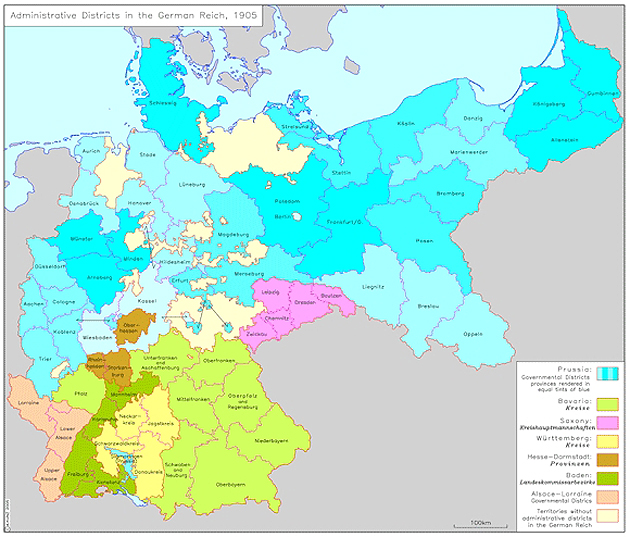













INTRODUCTION | DOCUMENTS | IMAGES | MAPS | EDITOR
|
Aside from Prussia, Hesse was the only other federal state with a provincial system. Likewise, the other large federal states had regional districts as a form of mid-level state administration, but the terms used for them varied. Thus, Bavaria and Württemberg were divided into districts [Kreise], Baden into districts headed by a superintendent [Landeskommissarbezirke], and Saxony into counties headed by captains [Kreishauptmannschaften]. There was no mid-level administration in the smaller federal states. The states with their own administrative structures enjoyed far-reaching administrative sovereignty. As a rule, they were responsible for administering imperial laws and attending to matters of general and internal administration, which included establishing procedures and regulations, maintaining their own police force, and collecting taxes and administering their own finances. Prussia dominated the German Empire in many ways. As the map below makes clear, it comprised two-thirds of the imperial territory, and accounted for 60% of the German population. Bismarck’s constitution and the expansion of Prussian bureaucracy, the priority Prussia enjoyed in the Federal Chamber on account of the fact that the Prussian king and the German Emperor were one and the same person (as were the Prussian prime minister and the German chancellor, with two exceptions), and the increasing militarization of society – all of this was perceived by critics as evidence of the “Prussianization” (“Verpreußung”) of Germany. The primacy of Prussia, however, was not the only weakness of the German Empire’s federal system. Its financing was also problematic: each state, for example, had to pay contributions to the federal government, which made the empire dependent on them. Moreover, some southern German states enjoyed special rights: Bavaria and Württemberg, for example, had their own postal systems and armies. Thus, no proper balance of power could be achieved among the federal states or between them and the empire.
Please click on print version (below) for a PDF file with enhanced resolution. This file is best viewed at 200-300%.
IEG-Maps, Institute of European History, Mainz / © A. Kunz, 2004 |
 print version
print version return to map list
return to map list previous map
previous map
